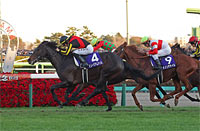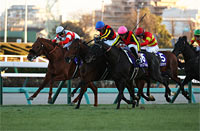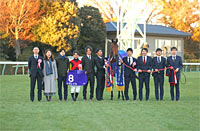2018 News
Arima Kinen (The Grand Prix) (G1) - PreviewThis Sunday, Dec. 23, showcases the last Grade 1 of the year for older horses - the Arima Kinen (The Grand Prix) -- and it’s a doozy, with Japan’s top three money earners in the lineup – Cheval Grand, Satono Diamond, and Rey de Oro (who was also the fans’ top pick). This year, just two days before Christmas, the Arima falls on the last official celebration of the birthday of the current emperor, and the 63rd running of this racing icon will also be the last of the Heisei Era. The full gate of 18 is set to include eight Grade 1 (including jump G1) champions and six of the 10 horses Japan’s racing fans most want to see. One that particularly stands out is Oju Chosan, the third most popular horse from a total of over 100,000 votes placed by fans. Though not likely to be among the trackmen’s top choices, Oju Chosan has captured hearts, not only because he’s on an 11-race winning streak that includes nine jump graded-stakes wins, five of them jump G1, but also because, after only two low-level starts on the flat, he and Yutaka Take are aiming for the pinnacle, the Arima winner’s circle. Getting there and bagging the race’s first-place prize of 300 million yen is the stuff of dreams, something the Arima has always been about. Nakayama Racecourse in Chiba Prefecture east of Tokyo is host to the 2,500-meter turf event, set to get under way at 3:25 p.m. Races at Nakayama are run to the right and the Arima, as well as the Grade 2 Nikkei Sho are the only races run at the venue’s 2,500-meter course. The inner “A” course measures nearly 1,700 meters around and the race starts just off the third turn on part of what is the outer course. The runners turn into the home stretch and pass once before the grandstand, then circle around again. The stretch has an upward slope beginning about 200 meters before the finish line, from where it rises 2 meters in less than 150 meters, a slope that the runners have to surmount twice. The Arima Kinen is the 11th race on the Sunday Nakayama card of 12. It’s open to 3-year-olds and up and horses carry 57 kg, with a 2-kg allowance given females and 3-year-old colts. Zenno Rob Roy set the current race record of 2 minutes 29.5 seconds in 2004. Here’s a look at the expected top picks. Rey de Oro – Likely race favorite and paired with regular rider Christophe Lemaire, Rey de Oro returns from winning the Tenno Sho (Autumn) and will be taking on his first race over a distance of 2,500 meters. He’s won twice at 2,400, including the Tokyo Yushun (Japanese Derby) and the Kobe Shimbun Hai (G2), so the extra half a furlong shouldn’t be a concern. He’s also won over the 2,200 meter course at Nakayama. It’ll be the King Kamehameha-sired 4-year-old’s first Arima Kinen, as he called it a year after running second in the 2017 Japan Cup. This year, Rey de Oro is being given five starts, as compared to only four in 2017, and his four so far have included a trip to Dubai, where he ran fourth in the Dubai Sheema Classic (G1, 2,410 meters). It’s been a tough year with some difficult race and close calls, but he edged Sungrazer for the win of the Tenno Sho (Autumn) and has had ample time to recover. After some R&R, Rey de Oro returned to Miho Training Center on Nov. 28 and is said to be refreshed and moving well. His trainer Kazuo Fujisawa has three wins of the Arima Kinen thus far. Another would tie the record currently held by Yasutoshi Ikee. Kiseki – Kiseki, a 4-year-old son of Rulership, won the Grade 1 Kikuka Sho (Japanese St. Leger) last year but has missed the winner’s circle in his six starts hence. He showed improvement after returning in the fall, finishing third in both the Mainichi Okan (G2, 1,800 meters) and the Tenno Sho (Autumn) (G1, 2,000 meters). He came closest last out in the Japan Cup, with a strong race that saw him finish second a length and three quarters behind Almond Eye (running under 4 kg less) and nearly 4 lengths ahead of Cheval Grand. This will be only his second time over 2,500 meters and his second time at Nakayama. He finished in ninth place the first time in the Nikkei Sho this past March, his first start after returning from Hong Kong 4 1/2 months earlier. His last three runs, all under Yuga Kawada (pegged for the Arima ride as well), have seen him adhere to a more-forward running style, one which may help him hold on for a share of the big money. Cheval Grand – Cheval Grand, a 6-year-old son of Heart’s Cry, finished sixth in his first Arima Kinen in 2016 after running third in the Japan Cup, and last year he missed second by a nose after winning the JC. This year, Cheval Grand was fourth in the Japan Cup, which going by the numbers may not bode well for the Arima. But, considering his gallant effort in the final stages of the JC that brought him within a neck of third and his second in the 3,200-meter Tenno Sho (Spring), it would also indicate that he’s not to be written off just yet. Hugh Bowman, who rode the 2017 JC, but was unable to ride this year due to a suspension, is expected to be in the saddle on Sunday. Trainer Yasuo Tomomichi says of Cheval Grand, “I can’t say he’s suited to the tighter turns of Nakayama, but he’s a dependable horse. I think he has a chance.” Blast Onepiece – The Harbinger colt Blast Onepiece is one of only two 3-year-olds among the 19 Arima Kinen nominees and the one attracting the most attention. With four wins in six starts, including two wins of Grade 3 races (one amid older company) and a fifth and a fourth in the Tokyo Yushun (Japanese Derby) and the Kikuka Sho (Japanese St. Leger), respectively. He’s been doing well enough, but the Arima may be just what he needs to blast into the headlines. He has excellent speed and can run from any position. Though it’ll be his first time at Nakayama, Blast Onepiece has proven himself over a right-handed track, as well as over softer ground. Based at Miho and trained by Masahiro Otake, he’ll have the home advantage as well as the weight advantage carrying only 55 kg. Satono Diamond – Though his recent performances have paled in comparison to his triumphant 3-year-old year, the now 5-year-old Satono Diamond may still be able to shine in what will be his last run. Winner of the 2016 Arima Kinen, the Deep Impact-sired Satono Diamond last year took the rest of the year off after returning from France and this year has managed only one win from five starts. Last out, he ran sixth under Joao Moreira in the Japan Cup a full 1.3 seconds behind the winner. Still, top Arima-winning trainer Yasutoshi Ikee has hope and says the Nakayama 2,500 is more forgiving than the Tokyo 2,400. “I’m hoping his experience and technique will help give him an edge.” Expected to have the ride is Australian jockey Brenton Avdulla, who will be riding in the Arima for his first time. Mikki Rocket – The 5-year-old Mikki Rocket, winner of this year’s Grade 1 Takarazuka Kinen, is somewhat surprisingly taking on his very first Arima Kinen. Returning after 4 months off for the Tenno Sho (Autumn) he managed a very respectable fifth, just 0.4 seconds off the winner. Mikki Rocket will be back at Nakayama for his first time since his Satsuki Sho (Japanese 2000 Guineas) run, where he flubbed the start and finished 13th of 18. With one race under his belt and much better at the break, improvement is likely. # # # Not quite ready to be written off is Makahiki, on whom the odds are likely to be attractive, having failed to win since France in September 2016 and having failed to meet expectations in six of his eight starts since, including in the Tenno Sho (Autumn) last out. Perhaps the rather flamboyant style of Yasunari Iwata, scheduled to ride Sunday for the first time, will give Makahiki the motivation he needs.
|

|



























